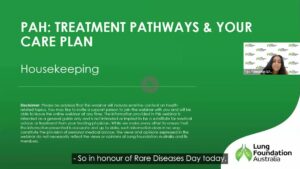In this webinar, Dr David Michail (Respiratory Specialist) provides an overview of Pulmonary Arterial Hypertension (PAH) and an insight into the current treatments and therapies to help you get the most out of your treatment and care. Three consumers living with PAH also join to share their lived experience and empowering insights into navigating their PAH care.
Pulmonary hypertension (PH) is a serious condition caused by various underlying issues, leading to different treatment approaches. It often results in significant symptoms like breathlessness, fatigue, and light-headedness, and can affect life expectancy. Diagnosing PH involves tests like echocardiography and right heart catheterisation to measure lung blood pressure.
PH is classified into five groups, with only the first group referred to as pulmonary arterial hypertension (PAH). Patients with PAH often experience delays in diagnosis, as symptoms can be mistaken for other conditions. It’s crucial for patients to see a PAH specialist for accurate diagnosis and treatment. Treatment includes medications targeting blood vessel changes, while other groups focus on treating the underlying cause.
Managing PAH involves regular assessments, including medical exams, walk tests, blood tests, and echocardiograms. Early and aggressive treatment with multiple medications is recommended to prevent disease progression. Non-medication strategies like rehabilitation, stress management, and proper breathing techniques are also important.
Patients should be involved in their care, understanding their condition status and treatment options. Access to a multidisciplinary team and participation in clinical trials can improve outcomes. The PAH patient charter outlines expectations for care, emphasising timely diagnosis, patient involvement, and access to comprehensive treatment and support.
For more information, patients can refer to resources like the Lung Foundation’s PAH patient charter and other educational materials.
There are a number of ways patients with PAH can improve their quality of life and navigate their condition more effectively. Some key points are shared by patients in this webinar.
Rest and pacing yourself: PAH can cause significant fatigue, so it’s important to rest regularly and do activities in small chunks. Prioritise important tasks and avoid overexertion. For example, if you have an important event, avoid other tiring activities beforehand.
Was this page helpful?
Good job! Please give your positive feedback
How could we improve this post? Please Help us.
